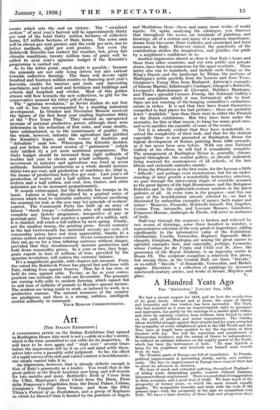Art
[Tun ITALIAN EXHIBITION.]
A CONSIDERED article on the Italian Exhibition that opened in Burlington House this week is not poosible at a day's notice, which is the time permitted to our critic for its inspection. It will have to be seen again and "slept over" several times before the impressions left by it on eye and mind settle them- selves into even a passably solid judgment. So far, the effect of a rapid survey of its rich and varied content is bewilderment:
one simply cannot take it in. -
An impression, however, that is already definite enough is that of Italy's generosity as a lender. You recall that in the great gallery at the Royal Academy now hang, and will remain for two months and more," Botticelli's Birth of -Venus from the Uffizi, Mantegna's Dead Christ from the Brera, Piero della Francesca's Flagellation from the Ducal Palace, Urbino, Giorgione's Tempest from Venice, and from the Pitti Titian's Portrait of an Englishman, and a group of Baptism in which La Donna Velata is flanked by the portraits of Angelo
and Maddalena Doni—these and many more works of world repute. Or, again, analysing the catalogue, you discover that throughout the rooms are hundreds of paintings and drawings, all of a certain and many of a supreme importance, drawn from two-score State Galleries and municipal and local museums in Italy. However stated, the generosity of the contribution strikes the imagination, and gratifies our pride by a neighbour's confidence in us.
Another impression almost as clear is that Italy's loans and those from other countries, and our own public and private stores, have been too numerous for the space available. These latter also run to hundreds, and include such things as the King's Duccio and the landscape by Titian, the portions of Mantegna's noble predella from the Louvre and from Tours,
Giorgione's Young Man from Budapest, Antwerp's examples of Simone Martini, Edinburgh's Castagno, Glasgow's Botticelli, Liverpool's Bartolommeo di Giovanni, Dublin's Mantegna, and Titian's splendid Comoro Family, the National Gallery's recent acquisition which it was fortunately able to lend.
Signs are not wanting of the hanging committee's embarrass- ments in riches. It is not that they have found themselves
compelled to find places for bad pictures : there are probably fewer doubtfuls here than there were in either the Flemish or the Dutch exhibitions. But they have been under the necessity, for this or that reason, to hang too many good ones, and so to sacrifice the ensemble of some of the rooms.
Yet it is already evident that they have wonderfully re- solved the complexity of their task, and that for the student especially there is now presented at Burlington House the logical development of Italian painting from 1200 onwards, as it has never been seen before. With our own National Gallery at his elbow, he will find it remarkably complete. The arrangement at Burlington House is, generally, chrono- logical throughout, the central gallery, as already indicated, being reserved for masterpieces of all schools, of the late fifteen and sixteenth centuries mainly.
From the Primitives in the first room, for the layman a little "difficult," and perhaps even monotonous, but for an under- standing of later growth a wonderfully instructive selection, we pass through the intervening stages of scientific research to the great figures of the high Renaissance, and the Bolognese Eclectics and to the eighteenth-century masters in the latest galleries of all. At every turn in the progress—and this one cause of the bewilderment already referred to—we find it illustrated by unfamiliar examples of names, both major and minor : Masaccio, Pisanello, Botticelli himself, Fra Angelico, Cosimo Tura, Antonello, and Lorenzo Monaco, Giamlbono, Francesco Morone, Ambrogio de Predis, will serve as instances of both.
Half-way through the sequence is broken and relieved by two rooms of drawings, some three hundred in number, a representative selection of the very greatest importance, adding significantly to the informative value of the Exhibition. Ghirlandaio, Uccello, Verrocchio, Raphael, Signorelli, Mich- elangelo, Giorgione, Mantegna, are among the great names to splendid examples here, and especially, perhaps, Leonardo, whose Cartoon for the Virgin and Child and St. Anne, the possession of the Royal Academy, is an imposing centre in Room IX. The sculpture comprises a relatively few pieces, but among them, in the Central Hall, are three "Davids," or so-called " Davids " of Donatello, Verrocehio, and Michel- angelo. Elsewhere is a collection of paintings by deceased nineteenth-century artists, and works in bronze, Majolica and










































 Previous page
Previous page